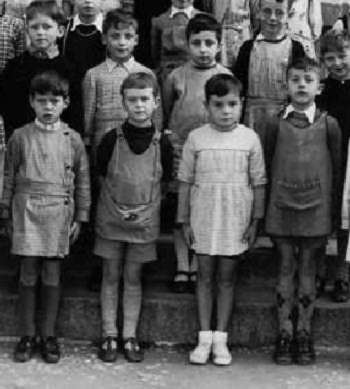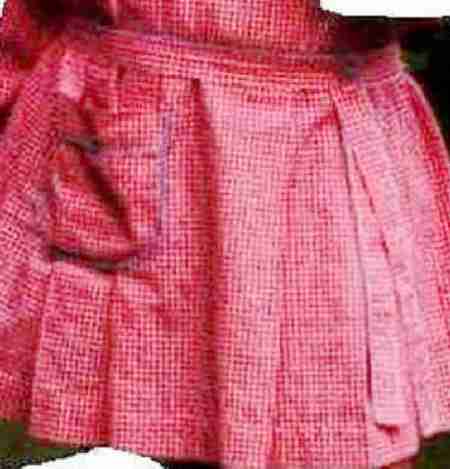
Figure 1.--Note the obvious large front pockets of the two boys with pinafore smocks. The pocket arrangements on the other smocks are more difficult to discern.


Figure 1.--Note the obvious large front pockets of the two boys with pinafore smocks. The pocket arrangements on the other smocks are more difficult to discern. |
Swiss boys wore a wide variety of smocks which had many different pocket arrangements. Of course boys like pockets to provide places where the various little treasures of boyhood could be secreted.
Some of the smocks worn by Swiss boys clearly have a front pocket. Many of the pinafore-style smocks have very obvious front pockets,
but some smocks look like they are very simple garments without any pockets at all. The available images, however, can be deciving. A Swiss source assures HBC that all smocks had at least one pocket. The pocket arrangements of back and side buttoning smocks are less easy to observe, but they did have pockets.
As a help to our French readers, we a providing a translation
of the summany paragraph. French readers have expressed a
special interest in smocks. Of course there commements in
French or English would be appreciated: Afin de faciliter la
lecture à nos visiteurs francophones nous avons traduit et
complété le paragraphe d'introduction en français. En effet de
nombreux lecteurs de langue française ont manifesté un grand
intérêt pour ces pages sur les tabliers d'école et nous les
invitons à nous faire tenir leurs commentaires et expériences
propres. Les garçons suisses ont portaient une grande variété de tabliers avec leurs poches réalisées en bien
des formes différentes. Naturellement les garçons aimaient bien avoir des poches pour y enfouir les divers
petits trésors que tout garçon garde jalousement. Certains des tabliers portés par les garçons ont
clairement une poche frontale. Plusieurs parmi les tabliers ne couvrant que le devant ont leur poche bien
apparente, quoique certains semblent n'être qu'une pièce de tissu simple sans aucune poche du tout. Il est
moins facile observer les agencements de poche des tabliers se boutonnant latéralement
ou dans le dos.
All Swiss smocks had pockets. The pockets on the pinafore smocks are for the most part easy to see. Pockets on the back and side buttoning smocks are harder to see in the available images, but they also had pockets. HBC had thought that some boys had smocks without pockets because they are not obvious on many avialable images. HBC's Swiss source is quite definitive, however, that smocks, whatever the style, all had a pocket.
Almost all smocks almost only had only one smock. A few smocks had two pockets. The only smocks with two povkets were the bacj buttoning smocks, but most of even this style only had one.
It is difficult to indicate any precise measure in centimeters (cm), especially as the actual size could be quite different for children of different ages, say 7 and 12 year olds. Smock pockets on the whole could be relatively small. Our Swiss source reports that smocks had pockets that were big enough that a boy could insert a bit more than closed wrist. Pockets of pinafore-style smocks were quite different in this respect. The pockets on these smocks were larger, easily reaching width of 18-20 cm and height about 15 cm. Of course the sizes of the pockets affected what a boy might keep in them.
HBC has collected the following ingformation on the pocket arrangements for the smocks worn by Swiss boys. For all types of smocks the pockets were always located right below belt. The pocket arrangement as to the side of the smock, this was in part determined by the smock style.
Many of the pinafore smocks had very large front pockets at the center. Others do not appear to have any. From the photographs, it's quite difficult to judge if there are any pockets on some of the pinafores as they might well be of same color as the rest of the smock. Furthermore two boys in the front row of one of the available photographs have just their hands hiding where pocket would be.
Many of the back buttoning smocks had pockets on the right side. This is the only smock style that might have more than one pocket. But even this style was most commonly made with only one pocket.
Many of the side-buttoning smocks had a pocket on the opposite side of the lateral buttoning. Normally the rule for boys was for the smock to be some shade of blue with buttoning on right side. As is observable in the available photographs, many boys have a smock with left buttoning. HBC believes that this was an option offered by manufacturers so that smock could be worn by either brother or sister.
HBC's Swiss contributor reports, "I don't remember as a boy seeing boys with smocks having the front buttonig in the middle of the fromt as was the case for some French smocks. Our smocks either buttoned at the side or back.
Imagine yourself as a 10-year old boy wearing a smock in the 1940s or 50s. What would you have in your smock pocket? Presumably what the boy just found during playtime, a nice little stone, a small piece of wood to use as a pistol, or a coin the boy got by selling two candies (the Swiss would say "bonbons", the English "sweeties) to friend during playtime. Another popular item was a conker on a string. (Yes Swiss boys lIke English boys had conker fights). If considered old enough, the boy in the more innocent school days of mid-century might have a small knife. (Most schools would now not permit boys to have knives of any type.) If having caught a cold, he would have his handkerchief in his pocket. He might have some candy even unwrapped
as they were sold in the candy store (sweet shop). After 1950, chewing gum was increasingly popular. A comon item was a piece of chalk he
just stole when he was at the blackboard. And certainly the main thing would have been marbles. Marbles were a popular game for all boys
since decades. (Actually milenia as boys in the Roman era were known to play with marbles.) The actual nature of the marbles and games differed, Swiss boys had marbles about 1.5 cm diameter, made
of baked clay. Boys rolled these balls pointing at another one
slightly bigger and usually made of glass and laid down at about
3 meters. Usually boys had bag with dozen of these marbles, but might bring only a few to school. In one word everything that mother hated to find there! HBC doesn't think it would be different from content of pants pockets for boys not wearing smocks. It might be that certain of these items would have been more commonly in pants pockets--the items more important to the boy. Ittems in pants pockets were more secure and thus less subject to possible loss when boy starts to race and jump around. Hankerchiefs are items a boy might commonly need during the day might be especially likely items for the smock pocket.
It would seem that the style of the smock would have some importance concerning pockets. A boy in a pinafore or apron style smock would seem to have little difficulty getting something from his shirt or pants pocket. HBC assumed that a boy wearing a back- or side-buttoning smock would have much more difficulty doing so. Thus he would problably use a pocket in his smock more than his shirt or pants pockets. Our Swiss contributor is less convinced. He assures HBC that there is no difficulty in reaching pants pocket. It just takes half a second more time, you lift smock with your tumb, reach the pocket and put in it what you had in hand. HBC notes, however, that Swiss school smocks in the 1940s-50 were generally quite short, ending well above the knees. Many do not even cover a boy's short pants. Smocks worn in other countries and during other periods were often much longer, extending sown to knee length. (For example, note how long some French school smocks were.) The shortness of the Swiss school smocks would of course would made it much easier to get to the contents of his pants pockets, especially if he was wearing a back-buttoning smock. Even the short Swiss school smocks (at least the side and back buttoning styles) would make it difficult to get to shirt pockets.

Figure 2.--This detail from a red gingham, back byttoning smock shows the blue detailing on the pocket and belt. |
Pockets were often used as a stylish element in smocks. On some smocks, the pockets and belts might have a boarder of a different color.
HBC wondered if there was a difference in the pocket arrangements of boys' and girls' smocks. Were the boys' smocks more likely to have pockets or larger ones? HBC's SWiss source reports that there was no difference in size nor location. He indicated that presumably for
girls the pockets might have a bit more decorative styling detail.
One might ask where a Swiss boy would keep his pens and pencils?
At primary school everything (books, copybooks, and pencils etc.) were provided to pupils by the school. Many of these "supplies" remained
in the class. When homework was assigned to older boys (about age 10), boys would keep their pens end pencils in a small leather penholder. The penholder was cairred in a book sachel boys commonly wore on their backs.
Navigate the Boys' Historical Clothing Smock pages:
[Return to the Main Swiss national school smock page]
[American]
[Argentine]
[Bolivia]
[English]
[French]
[Jamaican]
[Portuguese]
[Spanish]
[Turkish]
Navigate the Boys' Historical Clothing Smock-related pages:
[Pinafores]
[Fauntleroy suits]
[Fauntleroy dresses]
[Sailor hats]
[Park outings]
[French page]
[Renoir page]
[School smocks]
Navigate the Boys' Historical Clothing Web Site:
[Introduction]
[Activities]
[Biographies]
[Bibliographies]
[Chronology]
[Clothing styles]
[Contributions]
[Countries]
[Boys' Clothing Home]
